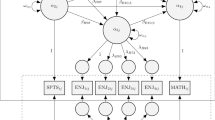Abstract
This paper discusses a new form of specifying and normalizing a Linear Logistic Test Model (LLTM) as suggested by Bechger, Verstralen, and Verhelst (Psychometrika, 2002). It is shown that there are infinitely many ways to specify the same normalization. Moreover, the relationship between some of their results and equivalent previous results in the literature is clarified, and it is shown that the goals of estimating and testing a single element of the weight matrix, for which they propose new methods, can be reached by means of simple, well-known tools already implemented in published LLTM software.
Similar content being viewed by others
References
Bechger, T.M., Verstralen, H.H.F.M., & Verhelst, N.D. (2002). Equivalent linear logistic test models.Psychometrika, 67, 123–136.
Bechger, T.M., Verhelst, N.D., & Verstralen, H.H.F.M. (2001). Identifiability of nonlinear logistic test models.Psychometrika, 66, 357–372.
Butter, R.P., De Boeck, P., & Verhelst, N.D. (1998). An item response model with internal restrictions on item difficulty.Psychometrika, 63, 47–63.
Fischer, G.H. (1983). Logistic latent trait models with linear constraints.Psychometrika, 48, 3–26.
Fischer, G.H. (1995). The linear logistic test model. In G.H. Fischer & I.W. Molenaar (Eds.),Rasch Models: Foundations, Recent Developments, and Applications. New York: Springer-Verlag.
Fischer, G.H., & Ponocny-Seliger, E. (1998).Structural Rasch Modeling. Handbook of the Usage of LPCM-WIN 1.0. Groningen, NL: ProGAMMA [see http://www.scienceplus.nl].
Hastie, T., Tibshirani, R., & Friedman, J. (2001).The Elements of Statistical Learning. New York: Springer-Verlag.
Nährer, W. (1979). Zur Analyse von Matrizenaufgaben mit dem linearen logistischen Testmodell. [On the analysis of matrices items by means of the linear logistic test model.]Zeitschrift für Experimentelle und Angewandte Psychologie, 27, 553–564.
Rasch, G. (1960).Probabilistic Models for Some Intelligence and Attainment Tests. Copenhagen: Pædagogiske Institut. (Expanded edition 1980. Chicago: The University of Chicago Press.)
Rost, J. (1966).Lehrbuch Testtheorie Testkonstruktion. [Textbook of test theory and test construction.] Bern: Verag Hans Huber.
Author information
Authors and Affiliations
Rights and permissions
About this article
Cite this article
Fischer, G.H. Remarks on “equivalent linear logistic test models” by Bechger, Verstralen, and Verhelst (2002). Psychometrika 69, 305–315 (2004). https://doi.org/10.1007/BF02295946
Received:
Revised:
Issue Date:
DOI: https://doi.org/10.1007/BF02295946




